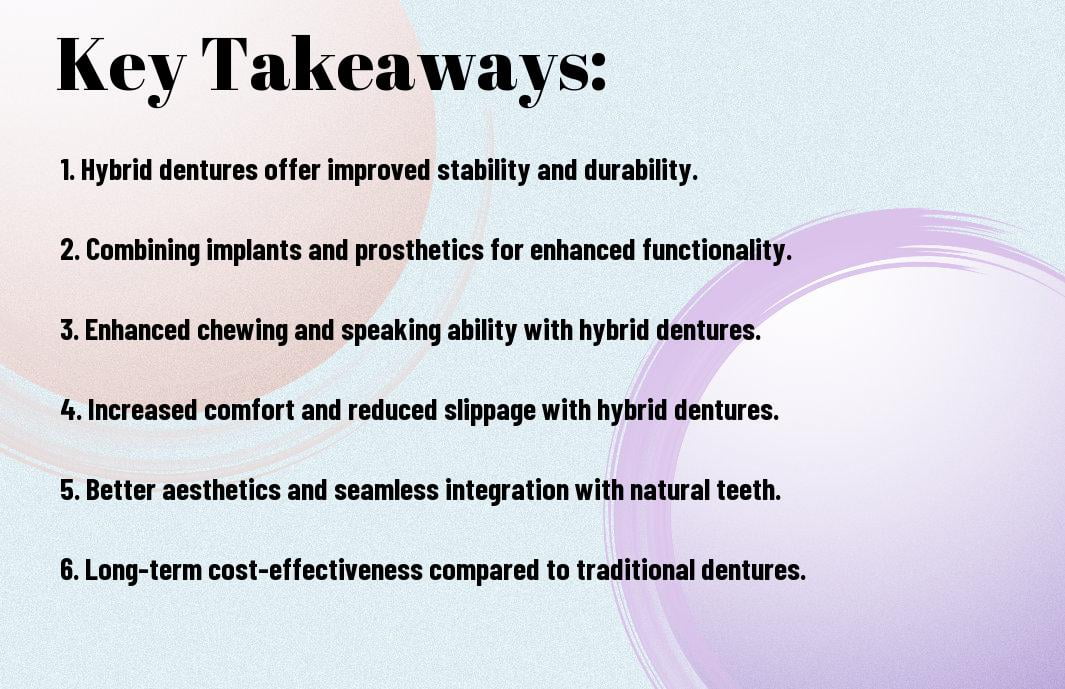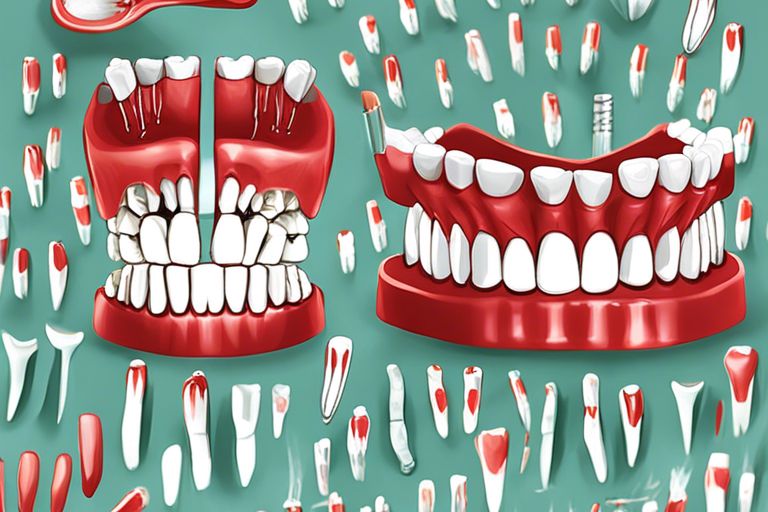It’s time to revolutionize the world of dentures with Hybrid Dentures. By combining the stability and durability of dental implants with the comfort and aesthetics of dentures, patients can now enjoy enhanced functionality and natural-looking smiles. This innovative solution not only provides a more secure fit and improved chewing ability but also prevents bone loss and promotes overall oral health. Say goodbye to the limitations of traditional dentures and hello to a more confident and comfortable smile with Hybrid Dentures.
Key Takeaways:
- Enhanced Stability: Hybrid dentures combine the stability of dental implants with the affordability and versatility of traditional dentures, providing patients with a more secure and comfortable fit.
- Improved Functionality: By anchoring the dentures to implants, patients can enjoy improved biting and chewing abilities, allowing them to confidently eat a wider variety of foods without concerns about slippage or shifting.
- Natural Look and Feel: Hybrid dentures are designed to closely mimic the look and feel of natural teeth, restoring patients’ confidence in their smiles and overall oral health.

Understanding Hybrid Dentures
While hybrid dentures are a relatively new concept in the field of dentistry, they are gaining popularity for their innovative approach to restoring oral function. By combining the stability of dental implants with the versatility of prosthetic dentures, hybrid dentures offer a comprehensive solution for individuals with missing teeth.
Definition and Components
One key feature of hybrid dentures is their composition, which typically includes a titanium implant that is surgically placed into the jawbone, an abutment that connects the implant to the denture, and a customized prosthetic appliance that is securely attached to the abutment. This combination allows for a natural-looking restoration that is both stable and functional.
Advantages Over Traditional Dentures
With hybrid dentures, patients can enjoy a range of benefits that set them apart from traditional removable dentures. To start with, the implanted portion of hybrid dentures provides a firm foundation that eliminates the risk of slipping or shifting, allowing for improved chewing efficiency and speech clarity. Additionally, the prosthetic portion of hybrid dentures is crafted to closely resemble natural teeth, offering a more aesthetic solution for tooth loss.
The Role of Dental Implants in Hybrid Dentures
Types of Implants Used
Clearly, dental implants play a crucial role in the success of hybrid dentures. The choice of implants is imperative to provide stability and support for the prosthetic restoration. There are primarily two types of implants used in hybrid dentures – endosteal and subperiosteal. Endosteal implants are placed directly into the jawbone, while subperiosteal implants are placed on top of the jawbone. Thy provide a strong foundation for the hybrid denture to be securely attached.
| Endosteal Implants | Subperiosteal Implants |
| Implanted directly into the jawbone | Placed on top of the jawbone |
| Most commonly used for hybrid dentures | Used when there is insufficient bone height |
| Provide excellent stability and support | May be a suitable option for patients with limited bone |
| Require healing time for osseointegration | Less invasive compared to endosteal implants |
The Osseointegration Process
An imperative step in the success of dental implants is the osseointegration process. This is when the implants fuse with the surrounding bone, creating a strong and stable foundation for the hybrid denture. The osseointegration process can take several months to complete, during which the implants become fully integrated with the jawbone.
A successful osseointegration process is crucial for the long-term stability and functionality of the hybrid denture. It ensures that the implants are securely anchored in the jawbone, providing the necessary support for the prosthetic restoration. This process is vital as it helps prevent implant failure and ensures a durable solution for missing teeth.
Design and Fabrication of Hybrid Dentures
Assessment and Treatment Planning
The assessment and treatment planning phase for hybrid dentures is crucial in determining the success of the final outcome. The dentist will perform a thorough examination of the patient’s oral health, bone structure, and overall dental condition to decide on the best course of action. This phase involves a series of diagnostic tests, imaging studies, and consultations to ensure the optimal placement of implants and prosthetics.
Materials and Manufacturing Techniques
One of the key elements in the design and fabrication of hybrid dentures is the choice of materials and manufacturing techniques. These dentures are typically made from a combination of durable metals such as titanium for the implants and high-quality acrylic or ceramic for the prosthetic teeth. The manufacturing process involves advanced technologies such as computer-aided design (CAD) and computer-aided manufacturing (CAM) to ensure precision and accuracy in creating the prosthetic components.
Plus, using high-quality materials and advanced manufacturing techniques not only ensures the durability and longevity of hybrid dentures but also enhances their aesthetic appeal and functionality for the patient.
Clinical Considerations and Maintenance
Patients Suitability and Selection Criteria
Patients considering hybrid dentures must undergo a thorough examination by a dental professional to determine their suitability for the procedure. Factors such as jawbone density, oral health, and overall medical history will be assessed to ensure the success of the treatment. Ideal candidates are those with good oral hygiene practices and a commitment to follow post-treatment care instructions.
Long-Term Care and Maintenance Requirements
To ensure the longevity and durability of hybrid dentures, proper long-term care and maintenance are imperative. Regular dental check-ups, meticulous oral hygiene routine, and avoiding hard or sticky foods are key to preserving the implants and prosthetics. Patients should also be aware of the potential signs of complications such as infection or implant failure and seek immediate professional help if any issues arise.
Care must be taken to follow the customized care plan provided by the dental team post-procedure. This includes regular cleanings and examinations to monitor the health of the implants and prosthetics. Any discomfort, pain, or loosening of the dentures should be reported promptly to the dentist for timely intervention and maintenance. By adhering to these guidelines, patients can enjoy the benefits of their hybrid dentures for years to come.
Future Trends in Hybrid Denture Technology
Innovations in Materials and Techniques
Your smile’s future with hybrid dentures looks bright as innovations in materials and techniques continue to advance. An array of new materials like zirconia and resin composites are being explored for their durability and aesthetic appeal. Cutting-edge techniques such as computer-aided design and manufacturing are revolutionizing the way dentures are crafted, resulting in more precise and comfortable fits for patients.
The Impact of Digital Dentistry on Hybrid Dentures
Hybrid dentures are undergoing a significant transformation with the integration of digital dentistry. Hybrid dentures allow for the seamless merging of 3D imaging, computer-aided design, and manufacturing processes. This integration enhances the accuracy of the fit, function, and overall aesthetic appeal of the dentures. Patients can now enjoy a more personalized treatment plan that caters to their unique dental needs.
Final Words
Now, you have learned about the benefits of hybrid dentures, which combine the stability of implants with the versatility of prosthetics to provide enhanced functionality for individuals with missing teeth. By incorporating both technologies, hybrid dentures offer improved chewing efficiency, speech clarity, and overall comfort. Consult with your dentist to see if hybrid dentures are a suitable option for restoring your smile and regaining confidence in your oral health.
FAQ
Q: What are hybrid dentures?
A: Hybrid dentures are a combination of dental implants and prosthetic teeth designed to enhance functionality and improve aesthetics for patients with missing teeth. They provide a more permanent and stable solution than traditional dentures.
Q: How do hybrid dentures work?
A: Hybrid dentures typically involve placing dental implants into the jawbone to serve as anchors for the prosthetic teeth. The prosthetic teeth are then attached to the implants, providing a secure and natural-looking restoration that allows for improved chewing and speaking abilities.
Q: Who is a suitable candidate for hybrid dentures?
A: Suitable candidates for hybrid dentures are individuals who have multiple missing teeth and are looking for a more permanent solution than traditional dentures. Good candidates should have overall good oral health and sufficient jawbone density to support the dental implants.






